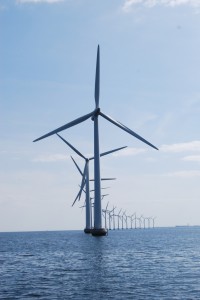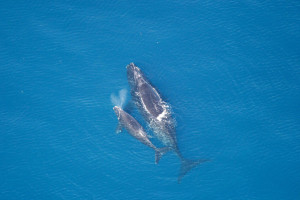We have much more to do and your continued support is needed now more than ever.
A Whale of a Tale for Offshore Wind Power

Ocean biodiversity is at risk from ocean acidification, rising water temperatures and sea-level rise caused by carbon pollution and climate change. The offshore wind power generation needed to reduce the carbon pollution threatening the ocean and beyond is finally upon us.
With the long-awaited arrival of this massive source of clean energy comes the obligation to do it correctly for wildlife. That’s why we’re thrilled today to have reached a landmark agreement with major offshore wind industry leaders and marine conservation organizations to protect the critically-endangered North Atlantic right whale—helping to ensure wind power can both stem the impacts of climate change and minimize its own impacts on marine wildlife.
Right Whales in Jeopardy
Scientists estimate that less than 500 North Atlantic right whales are currently roaming our Atlantic shorelines.

Right whales are sensitive to underwater noises, and there is concern that the early survey activities of offshore wind developers could disturb migrating whales and divert them off their typical course into areas where they may be more vulnerable to predation from sharks and orcas or collision with ocean vessels. With so few individuals left, scientists have suggested that the loss of even one or two female right whales poses a threat to the population as a whole.
Win-win for Whales & Offshore Wind Energy
We need rapid, responsible wind energy development in the Atlantic that avoids these types of unacceptable impacts. The exciting news is that the leaders in the U.S. offshore wind industry agree.
With colleagues at the Conservation Law Foundation, the Natural Resources Defense Council, New England Aquarium, and companies like Deepwater Wind, I spent the last few months navigating both the science on the right whale and the needs of a new industry. The agreement we reached in this first-of-its-kind collaboration balances the needs of industry, the conservation community and the right whale.
The agreement provides additional protections for the North Atlantic right whale, primarily by reducing or avoiding sound impacts from exploratory activities that developers use to determine where to build wind farms, such as the construction of temporary towers that measure weather conditions and underwater surveys that assess the geology just beneath the ocean floor.
The developers implementing these voluntary measures will have the greatest certainty of avoiding unacceptable impacts, and that in turn will remove barriers to the type of efficient, responsible permitting and development process NWF and ocean advocates can support.
Looking Forward
Our sights now turn to New England, an important location for right whale and wind energy, where similar measures could be developed. This is an ongoing venture, so we’ll strive to build support for these measures from more stakeholder and industry voices, and see them ultimately implemented.
I’m proud to work for an organization that seeks innovative collaboration as a tool to achieve conservation victories, and I’m hopeful that today’s agreement is the just the crest of the wave to bring responsible offshore wind power ashore—pun intended.
Help protect wildlife today by supporting offshore wind projects—take action now!





















